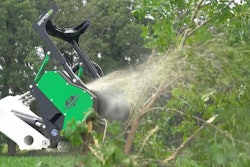 Photo: Jared Belson
Photo: Jared BelsonIn the prime of summer, you want your clients to enjoy their outdoor spaces, but if a yard has become home to fire ants, your customers may be reluctant to step outside and risk a bite from one of these painful devils.
While the damage they inflict is actually as a sting, not a bite, the pain is still serious, as the venom injected contains piperidine toxin that kills cells at the site of injection and causes a burning sensation. These stings generally swell into a bump or hive within 20 minutes. Hours or a day later, these will turn into fluid-filled pustules.
If a fire ant mound is disturbed, hundreds of ants will swarm out and begin stinging. Multiple stings can lead to serious medical reactions, even if the person is normally not allergic. For those experiencing an allergic reaction from a fire ant sting, symptoms include dizziness, nausea, headache and low blood pressure.
Anaphylactic shock can lead to death, so any person experiencing these symptoms should be taken to an emergency medical facility immediately.
As if this was not enough of a reason to dislike fire ants, the invasive species is known to ruin electrical equipment by building nests in utility boxes and can damage mowers.
The invasive species cost the United States around $6 billion annually for their control and repair of damages.
Identifying fire ants
Fire ants were introduced to the southern U.S. in the 1930s from South America via ships, and they have been present ever since. Because the ants are native to tropical regions, they tend to keep to the South. Locations farther north than Missouri currently don’t have a problem with these ants.
Fire ants are about a quarter-inch long and are reddish-brown to reddish-black in color. They often build mounds in sunny areas and are more likely to be found in open fields and lawns than forests.
Fire ant nests are unlike the majority of ant nests with one entrance and exit. Their mounds have multiple sides and underground tunnels. The nests tend to look like a pile of dirt that has been tilled. These ants are extremely aggressive, so any time their nest is disturbed, they will attack everything that is nearby.
When the mounds are left undisturbed, they can reach up 18 inches high and 24 inches wide. They take on a dome shape after two or three years.
Also, if left to their own devices, these fire ants may send additional queens to start new mounds nearby. Fire ants mate when the temperature is between 70 and 95 degrees Fahrenheit, with peak times during the spring and fall months.
Once the queen has established a group of new workers, she continues to lay 100,000 to 300,000 eggs per year and can live for six or seven years.
Controlling fire ants
If your client has had the misfortune of discovering fire ants have built a mound or mounds in their landscape, the options for controlling the irritating imps are limited.
The most popular and commonly cited control method is called the two-step method.
Step one is to broadcast an insecticide bait once or twice a year when the fire ants are active. This reduces the population by 80 to 90 percent, generally. For maximum effectiveness, baits should be applied between 70 and 85 degrees Fahrenheit, as this when fire ant foraging is the most frequent.
In the summer, baits should be applied in the evening, as baits lose their effectiveness in extreme heat and ants forage less in temperatures higher than 90 degrees Fahrenheit.
Before investing in a widespread insecticide, check to see if the ants are active and the bait is fresh. Place a small amount of bait and food in separate locations near the mound. If the bait is fresh and the ants are active, they will begin moving the bait within 30 minutes.
If the ants are active but are only feeding on the food left out, the bait has spoiled. If there is no activity on either, it is not a good time to treat. Strive to apply baits when no rain is expected for at least five hours, as soggy bait is unappealing to the ants.
While step one can decimate the majority of the ant population, the goal is to kill the queen, since as long as she lives the colony can repopulate. Fire ants do not eat solid foods but instead, they place solids on the “lip” of the late stage larvae who convert the liquid into solids. All other ants feed by passing this liquid food from ant to ant. This provides food tasters for the queen, and if an ant sickens from bad food, the queen is not fed from that food source.
Baits are formulated to act slowly enough that the queen eats the material before the effects take place. This is why patience is required before results are noticed in a fire ants’ hill.
If step two is necessary, this is following up and treating individual nuisance mounds that have not been killed off with the broadcasted bait. Take care to read the directions on the label, as the methods can vary and over-application can be detrimental to the environment.
For more long-term control of fire ants, there is the option of a broadcast application of a granular insecticide. This is not a bait and is relatively friendly to native ant species.
According to Clemson’s Cooperative Extension, these types of products are best for treating small areas, areas where high levels of control are desired or when the cost of treatment is not a concern, as the products are costly.
What doesn’t work
While some customers may oppose using chemical control methods, the home remedies floating around on the internet simply do not work.
If your client is talking about using grits, diatomaceous earth, boiling water or, heaven forbid, gasoline, save them the trouble and let them know these methods are ineffective and dangerous in some cases.
The goal is to kill the queen and while some of these may ease a vengeful soul and kill a lot of worker ants, they won’t get to the root of the problem, so their time and efforts will be wasted.









